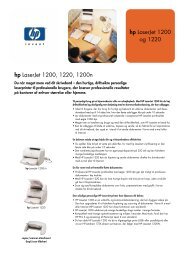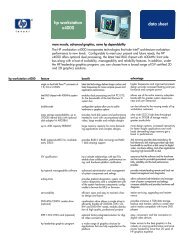Understanding pixel defects in TFT-LCD flat panel monitors
Understanding pixel defects in TFT-LCD flat panel monitors
Understanding pixel defects in TFT-LCD flat panel monitors
Create successful ePaper yourself
Turn your PDF publications into a flip-book with our unique Google optimized e-Paper software.
Defect type def<strong>in</strong>itions<br />
Bright/dark dot: A sub-<strong>pixel</strong> stuck on or off. "Stuck on" sub-<strong>pixel</strong>s almost always result from a failure<br />
of an associated transistor or other component with<strong>in</strong> the <strong>TFT</strong> array. Dark or "stuck off" sub-<strong>pixel</strong>s may<br />
also result from such failures, but may also be caused by contam<strong>in</strong>ation—a speck of dirt or debris<br />
trapped with<strong>in</strong> the <strong>LCD</strong> <strong>panel</strong>'s structure. It may be difficult to dist<strong>in</strong>guish these, but <strong>in</strong> the case of<br />
trapped debris the dark area will generally be irregularly shaped (rather than just the rectangular<br />
area of the sub-<strong>pixel</strong>), and may let small p<strong>in</strong>po<strong>in</strong>ts of light through at the edges of the debris.<br />
Bright spots/l<strong>in</strong>es: Spots or l<strong>in</strong>es that appear light <strong>in</strong> the display. Defects do not vary <strong>in</strong> size or<br />
<strong>in</strong>tensity (contrast) when the "gray level" of the <strong>pixel</strong> is varied. This variation can be achieved through<br />
the use of vary<strong>in</strong>g gray shade patterns). A bright l<strong>in</strong>e, extend<strong>in</strong>g from the top edge of the display to<br />
the bottom (or from either edge to the center), generally <strong>in</strong>dicates a failed column driver or<br />
connection; a similar failure caus<strong>in</strong>g a horizontal l<strong>in</strong>e generally <strong>in</strong>dicates a failed row driver or<br />
connection. A completely failed row or column driver IC will result <strong>in</strong> a large number of adjacent l<strong>in</strong>es<br />
appear<strong>in</strong>g dim, dark, or stuck on.<br />
Cluster: A group of defective sub-<strong>pixel</strong>s which are <strong>in</strong> close proximity to each other.<br />
Cross l<strong>in</strong>es off: When the unit lights, l<strong>in</strong>es <strong>in</strong> both the m<strong>in</strong>or and major axis do not appear.<br />
Dark spots/l<strong>in</strong>es (not limited to a specific sub-<strong>pixel</strong>): Spots or l<strong>in</strong>es that appear dark <strong>in</strong> the display<br />
patterns and are usually the result of contam<strong>in</strong>ation or failed drivers (see Bright spots/l<strong>in</strong>es, above).<br />
Defects do not vary <strong>in</strong> size or <strong>in</strong>tensity when the gray level is varied. (Identification of this can be<br />
achieved through the use of vary<strong>in</strong>g gray shade patterns). Contam<strong>in</strong>ation-related <strong>defects</strong> may not<br />
completely block the light emitted by some <strong>pixel</strong>s. A dark vertical l<strong>in</strong>e, extend<strong>in</strong>g from the top edge of<br />
the display to the bottom (or from either edge to the center), generally <strong>in</strong>dicates a failed column driver<br />
or connection; a similar failure caus<strong>in</strong>g a dark horizontal l<strong>in</strong>e generally <strong>in</strong>dicates a failed row driver<br />
or connection. A completely failed row or column driver <strong>in</strong>tegrated circuit (IC) will result <strong>in</strong> a large<br />
number of adjacent l<strong>in</strong>es appear<strong>in</strong>g dim, dark, or stuck on.<br />
Dim l<strong>in</strong>e: When the unit lights, l<strong>in</strong>e(s) <strong>in</strong> the vertical or horizontal axis appear dim, but not completely<br />
on or off. These <strong>defects</strong> are generally the result of a failure <strong>in</strong> the row (horizontal) or column (vertical)<br />
drivers or their connections. A completely failed row or column driver will result <strong>in</strong> a large number of<br />
adjacent l<strong>in</strong>es appear<strong>in</strong>g dim, dark, or stuck on.<br />
Mottl<strong>in</strong>g: Variation/non-uniformity ("splotch<strong>in</strong>ess") appears <strong>in</strong> what should be a uniform area (i.e., an<br />
area which is supposed to be all white, all black, or a s<strong>in</strong>gle color or gray level). The affected area<br />
can vary <strong>in</strong> size. This type of problem can result from non-uniform cell thickness <strong>in</strong> the LC <strong>panel</strong>s, or<br />
<strong>defects</strong> <strong>in</strong> the polarizers or other films used <strong>in</strong> the display or <strong>in</strong> their attachment to the substrate glass.<br />
Mura: Japanese for "blemish," the term "mura" (pronounced "moo-rah") has come to mean a spot or<br />
region of non-uniformity with<strong>in</strong> an LC display result<strong>in</strong>g from improper cell thickness <strong>in</strong> that region.<br />
Mura <strong>defects</strong> result from miss<strong>in</strong>g, <strong>in</strong>sufficient, or excessive spacers or foreign material <strong>in</strong> the affected<br />
region, or some other defect which has disturbed the cell thickness, and can <strong>in</strong> some cases appear<br />
after the <strong>panel</strong> has been manufactured, if it has been subjected to excessive pressure on the glass or<br />
extreme mechanical shock. The appearance of the affected region may also change with view<strong>in</strong>g<br />
angle.<br />
Newton's r<strong>in</strong>gs: A circular “ra<strong>in</strong>bow” effect (actually, an <strong>in</strong>terference pattern) which may be caused<br />
by non-uniform cell thickness or other <strong>defects</strong> result<strong>in</strong>g <strong>in</strong> a <strong>flat</strong> surface <strong>in</strong> contact with a slightly curved<br />
one.<br />
Polarizer dent: Physical damage to the polarizer that does not damage the glass. When the unit<br />
lights, spots appear bright (white) with display patterns dark and do not vary <strong>in</strong> size. This defect may<br />
not completely block the light emitted by any <strong>pixel</strong>s.















